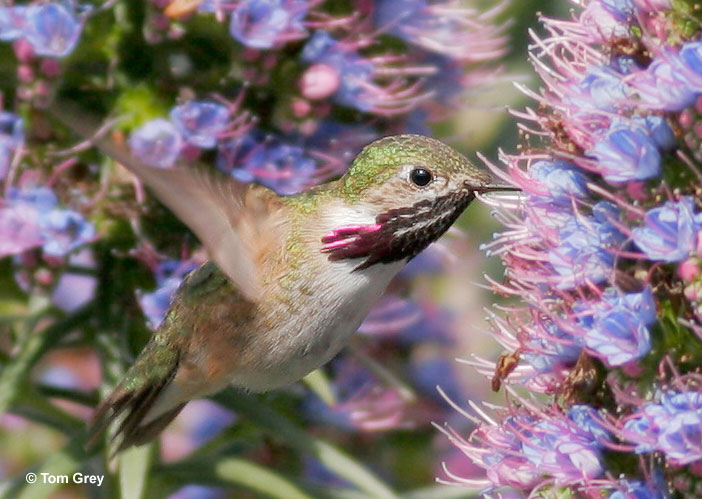Calliope Hummingbirds (Selasphorus calliope), native to western North America, are among the smallest bird species. Males boast unique iridescent magenta rays on their throats, whereas females have more modest plumage.
Think you saw one of them or you’re not quite sure which species it was? Here is some information to bring you more clarity!
On this page
Identification
Calliope Hummingbirds are tiny birds, measuring about 2.8 to 3.9 inches in length with a wingspan of 4.3 inches. They have a compact body and a hunched posture with short wings and a relatively short, straight bill.
The tail is square or slightly notched and is relatively short compared to other hummingbird species with the wingtips extending slightly past the end of the tip.
Male
Adult male Calliope Hummingbirds have vibrant and iridescent plumage and a dark tail. Their upperparts are generally green, and the underparts are pale with a white or grayish wash accentuated by pale green flanks. The throat (gorget) is covered with iridescent magenta or purplish-pink rays, that can appear almost black at certain angles.
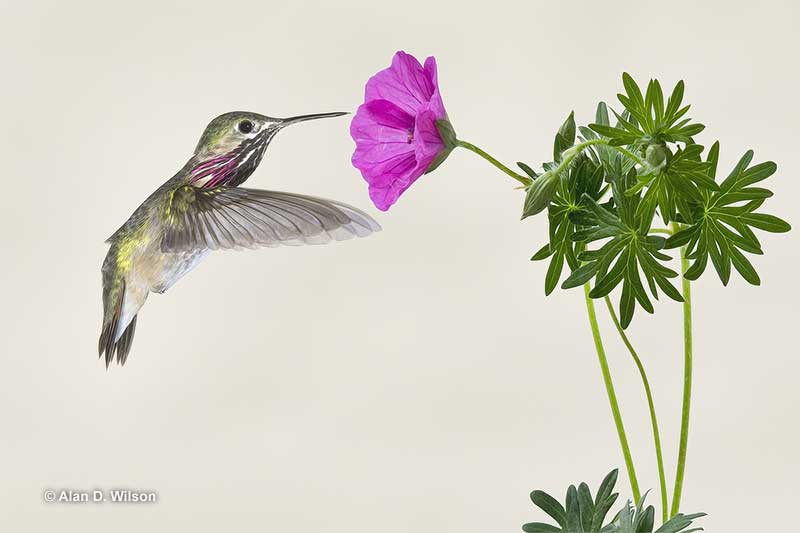
Immature males are more similar to females. They still have green uppersides and whitish undersides, but their flanks have a peachy wash. Their throat is pale with dark spotting and the occasional iridescent magenta feather.
Female
Female Calliope Hummingbirds, in contrast, lack the flashy throats present in males. They have a more subdued plumage with greenish upperparts and a white or buffy underbelly and pale peachy flanks. The females have faint streaky spotting on their throats, but it is far less prominent than in males. Their tail is also dark but has white tips.
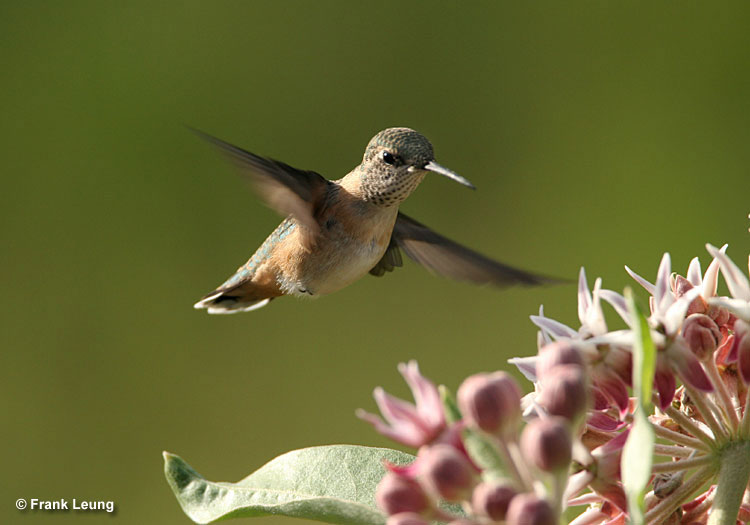
Juvenile Calliope Hummingbirds resemble adult females but may have more muted colors and less distinct markings. Young birds attain their full adult plumage after their first molt.
Vocalizations
While in flight, Calliope Hummingbirds produce a high-pitched, buzzing sound created by the rapid flapping of their wings. This noise is often described as a soft, insect-like hum.
During their courtship displays, male Calliope Hummingbirds generate a unique sound by diving through the air. This display is accompanied by a sharp, high-pitched zing sound, which is created by the air rushing through their feathers during the dives.
Calliope Hummingbirds’ calls are simple chips. They emit those while foraging or when encountering other birds.
Food
Calliope Hummingbirds’ diet primarily consists of nectar. They feed on a variety of cup-shaped or tubular flowers that grow close to the ground, mostly those that don’t catch the attention of larger and more aggressive hummingbird species.
Commonly, they are attracted to red flowers, but they also visit white, yellow, purple, and blue blossoms as well. Specific preferences may vary depending on the regions they inhabit.
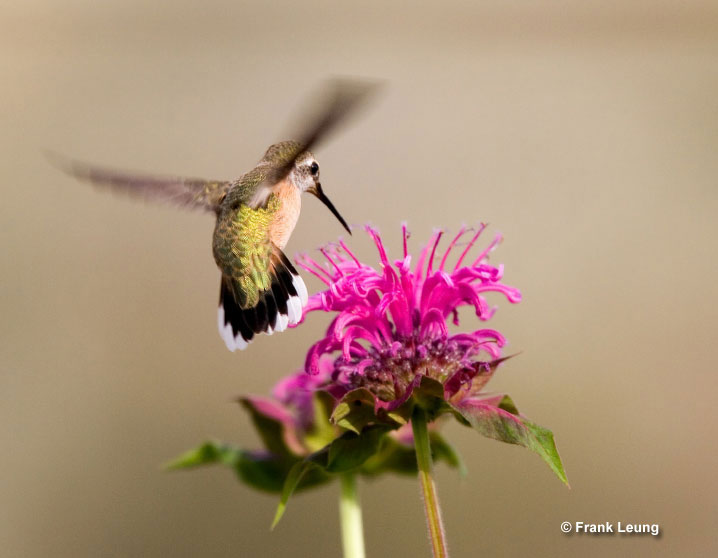
Some of their favorite plants include columbines, Indian paintbrushes, penstemons, trumpet gilias, larkspurs, and beardtongues. They forage by hovering in front of flowers and inserting their long bills and extendable tongues into the blossoms to extract nectar.
While nectar provides the energy needed for their high metabolism, Calliope Hummingbirds also consume small insects, such as flies, ants, bees, and spiders to meet their protein requirements. They catch their prey in flight or pluck them from vegetation. Sometimes they also feed on tree sap and pick insects that have gotten stuck in it.
Nesting and Eggs
Calliope Hummingbirds are not monogamous. Males mate with many females and leave them to nest, incubate, and care for the young on their own.
During the breeding season, males establish territories and then defend them aggressively against intruders, including huge ones, even Red-tailed Hawks.
They put on spectacular displays for the females, which includes them flying 100 feet into the air, performing U-shaped dives, and producing buzzing and high-pitched zing-calls. If a female perches on their territory, they hover before the female and flare their throat feathers.
After mating, the female builds a nest in the breeding territory, generally in a conifer tree under an overhanging branch. Calliope Hummingbird nests are cup-shaped and constructed of moss, bark fibers, plant down, and spider silk and camouflaged with bits of lichen. They are small and compact, measuring a bit under two inches wide and just over an inch high.
One female can have two broods in a year with 1-4, generally 2 white eggs in a clutch. Calliope Hummingbird eggs measure 0.4-0.5 inches long and only 0.3-0.4 inches wide. It takes 15-16 days for them to hatch. Until their first flight and independence at about 18-21 days of age, the mother hummingbird will feed and brood the young.
Current Situation
Calliope Hummingbirds range throughout western North America and southwestern Mexico. They are migratory birds.
Their breeding range extends throughout the western United States and southwestern Canada, while their wintering range covers southwestern Mexico.
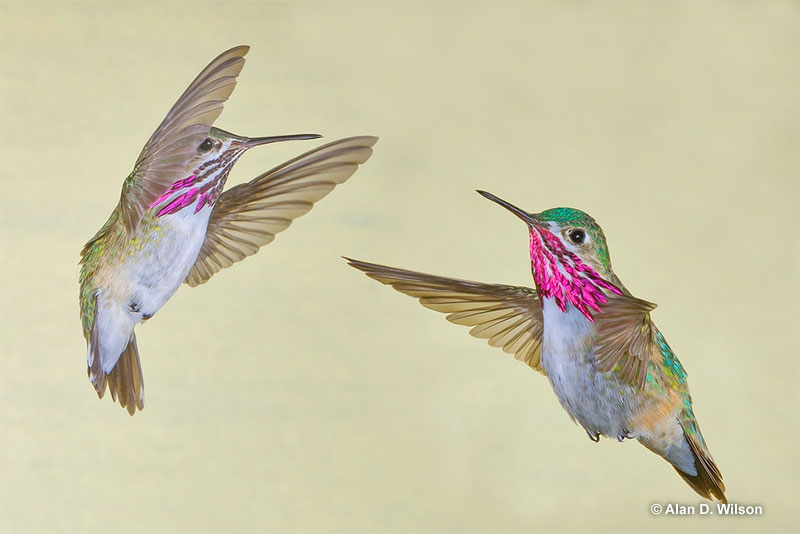
During the breeding season, they are found in higher elevations, often in mountainous areas. In the winter, they migrate to lower elevations.
Calliope Hummingbirds prefer mountainous and subalpine regions during the breeding season, mostly from 4,000 feet to up to near tree line.
They are commonly found in meadows, open woodlands, and areas with a mix of flowering plants. During migration and winter, they may inhabit a broader range of environments, including lowland areas, grasslands, scrub forests, gardens, and brushy habitats.
According to the IUCN Red List, Calliope Hummingbirds are a species of least concern. They are fairly and their population is fairly stable, if not slightly increasing. However, they are still vulnerable to habitat loss.
Facts
- The smallest living bird in the world is the Bee Hummingbird, measuring only slightly above 2 inches. Calliope Hummingbirds are only slightly larger, measuring just under three inches. They are the smallest native birds in North America.
- Calliope Hummingbirds are the smallest long-distance migrants in the world, undertaking a 5,000-mile journey each year.
- Despite their miniature size, Calliope Hummingbirds are still fierce and aggressive. They usually bow down to larger and more aggressive hummingbird species, like the Rufous Hummingbird, but will chase away larger birds as big and dangerous as the Red-tailed Hawk.
- Calliope Hummingbirds live for 4-6 years on average in the wild. The oldest recorded Calliope Hummingbird was at least 8 years and 1 month old.
Similar Species
Male Calliope Hummingbirds are rather unique thanks to their gorget. No other hummingbird species in North America has magenta rays on their throat. So, when it comes to similar species, we only have to worry about females. Let’s take a closer look.
Rufous Hummingbird
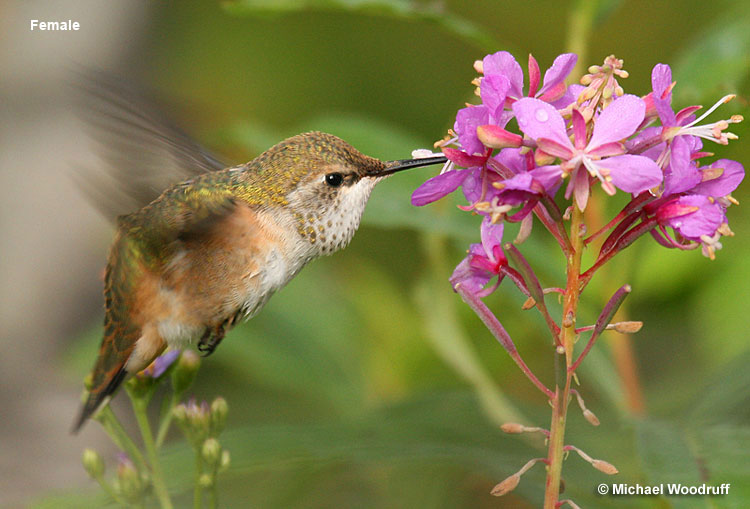
Female Rufous Hummingbirds are more similar to female Calliopes than males.
Rufous Hummingbirds range throughout western North America from southern Alaska down to Mexico. Males are beautiful coppery all over, whereas females are greenish above, have rust-colored patches on their tail, a whitish underside with peachy flanks, and green spots on the throat.
Compared to female Calliope Hummingbirds, female Rufous Hummingbirds have more and brighter orange in their plumage. In addition, their tail are longer than their wings when perched whereas the wings and tails of Calliope Hummingbirds are about the same length.
Broad-tailed Hummingbird
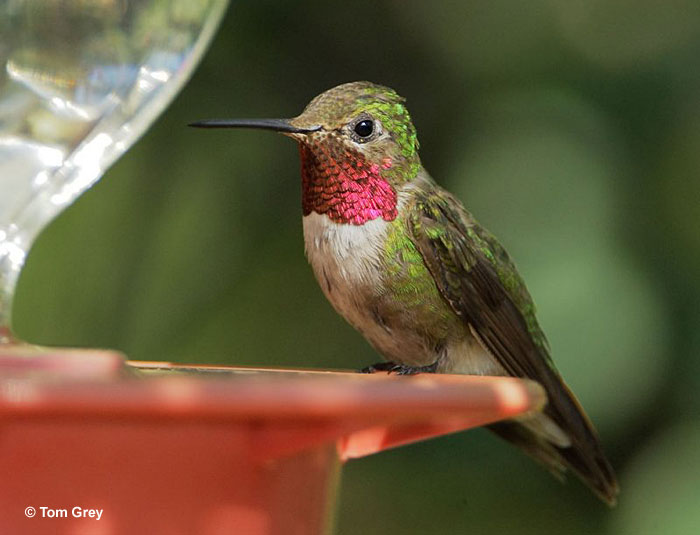
Broad-tailed Hummingbirds range throughout the western United States and Mexico. Males are green above and have a pale underside with greenish flanks and iridescent rosy-red gorgets. Females are similar but have a pale throat with green spotting and peachy flanks.
Overall, Calliope Hummingbirds are smaller than Broad-tailed Hummingbirds and have a thinner bill. The tails of Broad-tails extend beyond the wingtips, whereas for Calliopes, it’s the other way around. Males are fairly different, whereas females are otherwise very similar.
Frequently Asked Questions
How big are Calliope Hummingbirds?
Calliope Hummingbirds are very small, measuring only 2.8-3.9 inches long. They are the smallest bird species in North America.
How do you pronounce ‘Calliope Hummingbird’?
The Calliope in Calliope Hummingbird is pronounced as keh-LIE-eh-pee.
How long do Calliope Hummingbirds live?
Calliope Hummingbirds live for 4-6 years in the wild, with the oldest bird on record living a bit over 8 years.
Where do Calliope Hummingbirds live?
Calliope Hummingbirds live in the mountainous regions of western North America and winter in southwestern Mexico.

